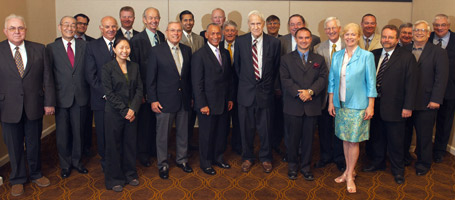Members of the National Space-Based Positioning, Navigation, and Timing (PNT) Advisory Board covered some old ground but gained some new insights today (October 30, 2015) during its meeting at the University Consortium for Atmospheric Research (UCAR) in Boulder, Colorado.
Members of the National Space-Based Positioning, Navigation, and Timing (PNT) Advisory Board covered some old ground but gained some new insights today (October 30, 2015) during its meeting at the University Consortium for Atmospheric Research (UCAR) in Boulder, Colorado.
Among topics discussed on the opening day were the Adjacent Band Compatibility (ABC) Assessment being led by the U.S. Department of Transportation, Office of the Secretary for Research and Technology (OST-R), an “economic impact” study of GPS, and plea to maintain current specifications for the GPS signal “side lobes” to support a substantial space service volume, that is, the region surrounding the Earth in which GPS and other GNSS signals can be used for navigation and space science.
The board advises the Space-Based Positioning, Navigation, and Timing (PNT) Executive Committee (ExCom), an interagency group cochaired by the deputy secretaries of transportation and defense. It cannot mandate compliance with its recommendations to U.S. agencies but under its new chairman John Stenbit seeks to create a shared vision of GPS policies, standards, and support across the federal government.
The ABC assessment is part of a plan to develop masks — a set of power limits by frequency — for the for 100 megahertz of spectrum on either side of the GPS/GNSS L1 signal at 1575.42 MHz. Eventually involving the testing of GPS civil receivers as well as those capable of processing foreign GNSS signals, the masks are a way to give potential users of frequencies neighboring the GPS frequencies clear limits against which to measure their plans and proposals.
The initiative hopes to have a proposed test plan and procedures ready for public comment by the end of the year, a list completed by January of receivers to be tested, and the beginning of tests by March 2016, according to Karen Van Dyke, OST-R Director, Positioning, Navigation, and Timing and Spectrum Management.
Consultant Irv Leveson, an economist with ASCR Federal Research and Technology Solutions LLC who led the first phase of the economic impact study, came back with an outline for “furthering the analysis.” His initial “review of the literature,” which he acknowledged only covered a part of the question — mostly the value of GPS receiver equipment, found that GPS boosted the American economy by $37.1 to $74.5 billion dollars in 2013, the most recent year for which data was available, with a mid-range estimate of $55.7 billion.
Following a tasking to the Commerce Department by the ExCom at its September 3 meeting, the study will be extended and expanded to address categories of receiver equipment omitted from the first rounds, as well as indirect and induced benefits of GPS that reflect the multiplier effect of using the technology to improve the efficiency of existing economic activity and enable entirely new applications.
The ExCom also wants the study to address the economic costs of the partial or complete loss of GPS service in the United States. As Leveson and board members observed, given the role of GPS timing in financial transactions, communications networks, and the electrical power grid alone, the number would be huge. Add in the plans to base the nation’s modernizing air transportation system on GPS positioning and the cost of losing GPS could easily run into the hundred of billions or even trillions of dollars a year.
Expanding the Reach of GPS
Frank Bauer, a longtime NASA engineer now working as a consultant, briefed the board on the progress of efforts to ensure a robust space service volume (SSV) by maintaining the current specifications for GPS signal transmissions. Currently the Earth-centered signals radiate a distance to either side of the planet, stronger in the “main lobe” of the transmissions but also propagating in an even wider spread called “side lobes.” These can be used at altitudes higher than the middle Earth orbits of GPS and other GNSS satellites.
As an example of GPS and GNSS importance for high-altitude space science, Bauer presented initial results from the Magnetospheric Multiscale (MMS) mission launched earlier this year that sent four identically equipped spacecraft — each the size of a baseball stadium when its eight instrument booms are deployed — flying in formation in a highly elliptical orbit.
Led by NASA’s Goddard Space Flight Center in Greenbelt, Maryland, the mission is studying a poorly understood phenomenon called magnetic reconnection, which occurs when magnetic fields from the sun connect and disconnect with magnetic fields of Earth. Magnetic reconnection underlies space weather events that can disrupt low-Earth-orbiting spacecraft and lead to communications and power blackouts on Earth.
In addition to 25 onboard sensors, the MMS spacecraft contain a GPS Navigator developed by Goddard scientists that is crucial to the success of the mission. The MMS study design requires the four spacecraft to arrange themselves into a pyramid-shape formation that places the spinning spacecraft just 6.2 miles (10 kilometers) apart as their sensors gather data. At the highest point of the MMS orbit reaches more than 43,500 miles above the Earth’s surface — well above the orbits of GPS satellites at about 12,550 miles altitude.
Bauer said the MMS spacecraft are receiving usable GPS signals from four or more GPS satellites 100 percent of the time.
Modernization plans for GPS and other GNSS systems, however, could narrow the spread of the signals’ main and side lobes as part of an effort to reduce the power requirements of new generations of satellites.
The meeting will continue tomorrow and then hand the venue over to the 10th meeting of the International Committee on GNSS (ICG), which begins on Sunday (November 1, 2015).





